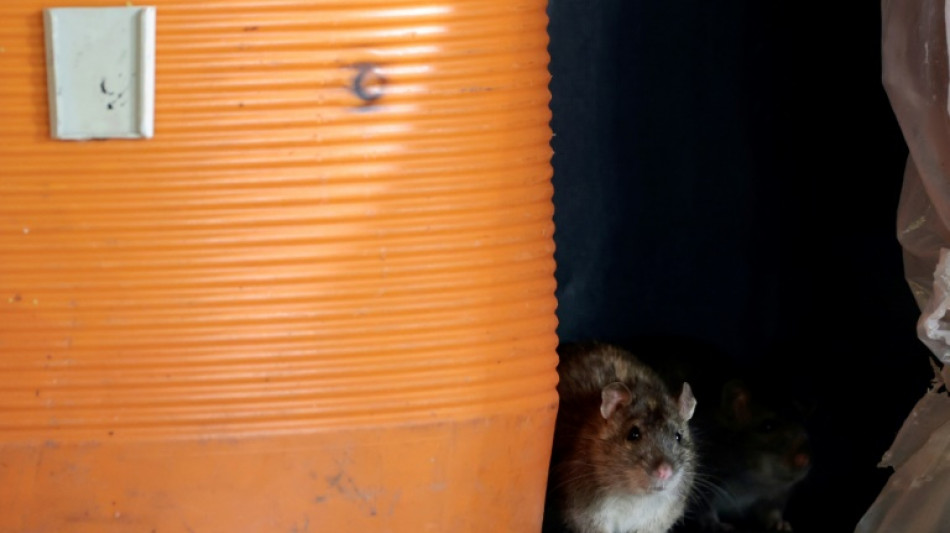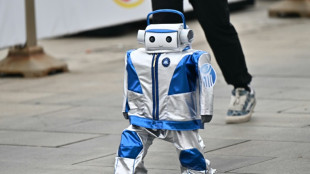
-
 Vance discusses migration during Vatican meeting with pope's right-hand man
Vance discusses migration during Vatican meeting with pope's right-hand man
-
Afghan FM tells Pakistan's top diplomat deportations are 'disappointment'

-
 British cycling icon Hoy and wife provide solace for each other's ills
British cycling icon Hoy and wife provide solace for each other's ills
-
Money, power, violence in high-stakes Philippine elections

-
 Iran, US hold second round of high-stakes nuclear talks in Rome
Iran, US hold second round of high-stakes nuclear talks in Rome
-
Japanese warships dock at Cambodia's Chinese-renovated naval base

-
 US Supreme Court pauses deportation of Venezuelans from Texas
US Supreme Court pauses deportation of Venezuelans from Texas
-
Pakistan foreign minister arrives in Kabul as Afghan deportations rise

-
 Heat and Grizzlies take final spots in the NBA playoffs
Heat and Grizzlies take final spots in the NBA playoffs
-
Iran, US to hold second round of high-stakes nuclear talks in Rome

-
 Humanoid robots stride into the future with world's first half-marathon
Humanoid robots stride into the future with world's first half-marathon
-
Migrant's expulsion puts Washington Salvadorans on edge

-
 Plan for expanded Muslim community triggers hope, fear in Texas
Plan for expanded Muslim community triggers hope, fear in Texas
-
Pakistan foreign minister due in Kabul as deportations rise

-
 White House touts Covid-19 'lab leak' theory on revamped site
White House touts Covid-19 'lab leak' theory on revamped site
-
Dodgers star Ohtani skips trip to Texas to await birth of first child

-
 US senator says El Salvador staged 'margarita' photo op
US senator says El Salvador staged 'margarita' photo op
-
Ford 'adjusts' some exports to China due to tariffs

-
 Thomas maintains two-shot lead at RBC Heritage
Thomas maintains two-shot lead at RBC Heritage
-
US to withdraw some 1,000 troops from Syria

-
 Four killed after spring storms wreak havoc in the Alps
Four killed after spring storms wreak havoc in the Alps
-
Spurs' Popovich reportedly home and well after 'medical incident'

-
 Trump goes to war with the Fed
Trump goes to war with the Fed
-
Celtics chase second straight NBA title in playoff field led by Thunder, Cavs

-
 White House site blames China for Covid-19 'lab leak'
White House site blames China for Covid-19 'lab leak'
-
Norris edges Piastri as McLaren top Jeddah practice

-
 Trump warns US could ditch Ukraine talks if no progress
Trump warns US could ditch Ukraine talks if no progress
-
Judge denies Sean 'Diddy' Combs push to delay trial

-
 80 killed in deadliest US attack on Yemen, Huthis say
80 killed in deadliest US attack on Yemen, Huthis say
-
Lebanon says two killed in Israeli strikes in south

-
 Trump says US will soon 'take a pass' if no Ukraine deal
Trump says US will soon 'take a pass' if no Ukraine deal
-
F1 success is 'like cooking' - Ferrari head chef Vasseur

-
 Cycling mulls slowing bikes to make road racing safer
Cycling mulls slowing bikes to make road racing safer
-
Macron invites foreign researchers to 'choose France'

-
 Klopp 'happy' in new job despite Real Madrid rumours: agent
Klopp 'happy' in new job despite Real Madrid rumours: agent
-
Alcaraz into Barcelona semis as defending champion Ruud exits

-
 Vance meets Italy's Meloni before Easter at the Vatican
Vance meets Italy's Meloni before Easter at the Vatican
-
Evenepoel returns with victory in Brabantse Pijl

-
 Maresca confident he will survive Chelsea slump
Maresca confident he will survive Chelsea slump
-
Mob beats to death man from persecuted Pakistan minority

-
 Lebanon says one killed in Israeli strike near Sidon
Lebanon says one killed in Israeli strike near Sidon
-
Arsenal's Havertz could return for Champions League final

-
 US officials split on Ukraine truce prospects
US officials split on Ukraine truce prospects
-
Client brain-dead after Paris cryotherapy session goes wrong

-
 Flick demands answers from La Liga for 'joke' schedule
Flick demands answers from La Liga for 'joke' schedule
-
'Maddest game' sums up Man Utd career for Maguire

-
 Trial opens for students, journalists over Istanbul protests
Trial opens for students, journalists over Istanbul protests
-
Gaza rescuers say Israeli strikes kill 24 after Hamas rejects truce proposal

-
 'Really stuck': Ukraine's EU accession drive stumbles
'Really stuck': Ukraine's EU accession drive stumbles
-
'Not the time to discuss future', says Alonso amid Real Madrid links


Forget mammoths, study shows how to resurrect Christmas Island rats
Ever since the movie Jurassic Park, the idea of bringing extinct animals back to life has captured the public's imagination -- but what might scientists turn their attention towards first?
Instead of focusing on iconic species like the woolly mammoth or the Tasmanian tiger, a team of paleogeneticists have studied how, using gene editing, they could resurrect the humble Christmas Island rat, which died out around 120 years ago.
Though they did not follow through and create a living specimen, they say their paper, published in Current Biology on Wednesday, demonstrates just how close scientists working on de-extinction projects could actually get using current technology.
"I am not doing de-extinction, but I think it's a really interesting idea, and technically it's really exciting," senior author Tom Gilbert, an evolutionary geneticist at the University of Copenhagen, told AFP.
There are three pathways to bringing back extinct animals: back-breeding related species to achieve lost traits; cloning, which was used to create Dolly the sheep in 1996; and finally genetic editing, which Gilbert and colleagues looked at.
The idea is to take surviving DNA of an extinct species, and compare it to the genome of a closely-related modern species, then use techniques like CRISPR to edit the modern species' genome in the places where it differs.
The edited cells could then be used to create an embryo implanted in a surrogate host.
Gilbert said old DNA was like a book that has gone through a shredder, while the genome of a modern species is like an intact "reference book" that can be used to piece together the fragments of its degraded counterpart.
His interest in Christmas Island rats was piqued when a colleague studied their skins to look for evidence of pathogens that caused their extinction around 1900.
It's thought that black rats brought on European ships wiped out the native species, described in an 1887 entry of the Proceedings of the Zoological Society of London as a "fine new Rat," large in size with a long yellow-tipped tail and small rounded ears.
- Key functions lost -
The team used brown rats, commonly used in lab experiments, as the modern reference species, and found they could reconstruct 95 percent of the Christmas Island rat genome.
That may sound like a big success, but the five percent they couldn't recover was from regions of the genome that controlled smell and immunity, meaning that the recovered rat might look the same but would lack key functionality.
"The take home is, even if we have basically the perfect ancient DNA situation, we've got a really good sample, we've sequenced the hell out of it, we're still lacking five percent of it," said Gilbert.
The two species diverged around 2.6 million years ago: close in evolutionary time, but not close enough to fully reconstruct the lost species' full genome.
This has important implications for de-extinction efforts, such as a project by US bioscience firm Colossal to resurrect the mammoth, which died out around 4,000 years ago.
Mammoths have roughly the same evolutionary distance from modern elephants as brown rats and Christmas Island rats.
Teams in Australia meanwhile are looking at reviving the Tasmanian tiger, or thylacine, whose last surviving member died in captivity in 1936.
Even if gene-editing were perfected, replica animals created with the technique would thus have certain critical deficiencies.
"Let's say you're bringing back a mammoth solely to have a hairy elephant in a zoo to raise money or get conservation awareness -- it doesn't really matter," he said.
But if the goal is to bring back the animal in its exact original form "that's never going to happen," he said.
Gilbert admitted that, while the science was fascinating, he had mixed feelings on de-extinction projects.
"I'm not convinced it is the best use of anyone's money," he said. "If you had to choose between bringing back something or protecting what was left, I'd put my money into protection."
J.Fankhauser--BTB


